Sierra Monitor Corporation 5100-03-IT User manual

MODEL 5100-XX-IT
IT Series
TOXIC GAS SENSOR MODULE
Version 3.00A
APPLICABILITY & EFFECTIVITY
Effective for all Model 5100-XX-IT Modules manufactured after December 1, 2011.
5100-03-IT
5100-04-IT
5100-05-IT FM Approved
5100-06-IT
5100-08-IT
5100-10-IT
5100-12-IT
5100-25-IT
5100-26-IT
Instruction Manual Part Number T12020
Rev. C

Model 5100-XX-IT Toxic Gas Sensor Module
FM PERFORMANCE APPROVAL
ONLY THE FOLLOWING ITEMS, FUNCTIONS AND OPTIONS ARE FM*APPROVED
Model 5100-05-IT Hydrogen Sulfide Gas Sensor Module
Sensor Module
Model 5100-05-IT Sensor Module - Hydrogen Sulfide
Calibration Equipment
Model 1250-01 Gas Sensor Calibration Kit, Type A
Model 1260-05 Hydrogen Sulfide in N2, 25 ppm Gas Cylinder
Model 1260-45 Hydrogen Sulfide in N2, 10 ppm Gas Cylinder
Model 5358-01 Calibration Adapter
Notes:
1) Apparatus must be installed in accordance with National Electrical Code.
2) FM Comments
*FM Approvals, a subsidiary of FM Global
Project# 3034435

Model 5100-XX-IT Toxic Gas Sensor Module
Contents
TABLE OF CONTENTS
1. PRODUCT DESCRIPTION.................................................................................................................................1
1.1 GENERAL........................................................................................................................................................1
1.2 PRODUCT CONFIGURATION........................................................................................................................1
1.3 THEORY OF OPERATION..............................................................................................................................2
1.4 MODES OF OPERATION................................................................................................................................2
1.5 MECHANICAL .................................................................................................................................................3
1.6 INTERCONNECT WIRING..............................................................................................................................3
1.7 POWER REQUIREMENTS .............................................................................................................................3
2. CAUTIONS & WARNINGS.................................................................................................................................6
2.1 INTRODUCTION .............................................................................................................................................6
2.2 GAS SENSOR MODULES - GENERAL..........................................................................................................6
2.3 WIRING............................................................................................................................................................6
2.4 CALIBRATION FREQUENCY .........................................................................................................................6
3. QUICK START....................................................................................................................................................7
3.1 OVERVIEW......................................................................................................................................................7
3.2 WIRING............................................................................................................................................................7
3.3 MODULE INSTALLATION...............................................................................................................................7
3.4 TRANSMITTER INSTALLATION ....................................................................................................................7
3.5 START-UP & OPERATION .............................................................................................................................7
3.6 ZERO STABILIZATION ...................................................................................................................................7
4. INSTALLATION..................................................................................................................................................8
4.1 SENSOR MODULE LOCATIONS ...................................................................................................................8
4.2 WIRING............................................................................................................................................................9
4.3 ENCLOSURE INSTALLATION......................................................................................................................10
4.4 TRANSMITTER AND SENSOR INSTALLATION .........................................................................................10
4.5 MODULE ADDRESS SWITCH ......................................................................................................................12
5. OPERATION.....................................................................................................................................................18
5.1 INTRODUCTION ...........................................................................................................................................18
5.2 DATA ENTRY KEYPAD ................................................................................................................................18
5.3 MAIN MENU ..................................................................................................................................................19
5.4 SET-UP..........................................................................................................................................................20
5.5 MAINTENANCE SUB-MENU ........................................................................................................................23
6. CALIBRATION..................................................................................................................................................24
6.1 CALIBRATION FREQUENCY .......................................................................................................................24
6.2 CALIBRATION PREPARATION....................................................................................................................24
6.3 CALIBRATION GAS DELIVERY METHODS.................................................................................................24
6.4 SENSOR EXPOSURE TO GAS ....................................................................................................................24
6.5 CALIBRATION SUB-MENU...........................................................................................................................25
7. SERVICE...........................................................................................................................................................26
7.1 SENSOR MODULE CONFIGURATION ........................................................................................................26
7.2 ENCLOSURE REPLACEMENT ....................................................................................................................26
7.3 TRANSMITTER REPLACEMENT .................................................................................................................27
7.4 SENSOR REPLACEMENT............................................................................................................................27
7.5 INSTALLATION INSPECTION ......................................................................................................................27
7.6 INSPECTION AND TROUBLESHOOTING GUIDE.......................................................................................28

Model 5100-XX-IT Toxic Gas Sensor Module
Contents
8. APPENDICES...................................................................................................................................................29
8.1 APPENDIX A: SPECIFICATIONS..................................................................................................................29
8.2 APPENDIX B: MODEL NUMBERS &PARTS LIST .......................................................................................32
8.3 APPENDIX C: LIMITED WARRANTY............................................................................................................33
8.4 APPENDIX D: REMOTE SENSOR DRAWING .............................................................................................34
8.5 APPENDIX E: MODBUS MEMORY MAP ......................................................................................................35
8.6 APPENDIX F: HART ......................................................................................................................................36
8.7 APPENDIX G: MENU KEY FOR 5100-XX-IT GAS SENSOR MODULE........................................................43
8.8 APPENDIX H: 5100-25-IT &5100-26-IT GAS SENSOR MODULE ...............................................................46
8.9 APPENDIX I: 5100-05-IT FM PERFORMANCE APPROVAL........................................................................50
8.10 APPENDIX J: 5100-XX-IT SIL-2 CERTIFICATES .........................................................................................52
8.11 APPENDIX K: 5100-05-IT ATEX CERTIFICATE...........................................................................................55
LIST OF FIGURES
FIGURE 1 - 1: MODEL 5100-05-IT-AL TOXIC GAS SENSOR MODULE ALUMINUM – DIMENSIONS................4
FIGURE 1 - 2: MODEL 5100-05-IT-SS TOXIC GAS SENSOR MODULE STAINLESS STEEL – DIMENSIONS ..4
FIGURE 1 - 3: MODEL 5100-XX-IT TOXIC GAS SENSOR MODULE – MOUNTING OPTIONS...........................5
FIGURE 4 - 1: TYPICAL MOUNTING OPTIONS.....................................................................................................8
FIGURE 4 - 2: TRANSMITTER FACE PLATE .......................................................................................................12
FIGURE 4 - 3: INTERFACE BOARD CONNECTORS...........................................................................................13
FIGURE 4 - 4: RS-485: TERMINATION, BIAS JUMPER ......................................................................................13
FIGURE 4 - 5: MA CIRCUIT TYPES ......................................................................................................................14
FIGURE 4 - 6: 4-20 MA CIRCUIT TYPE CONNECTIONS FOR 5100-XX-IT ........................................................15
FIGURE 4 - 7: WRITING CONNECTIONS FOR MODBUS AND SENTRY INTERFACE.....................................16
FIGURE 4 - 8: WIRING CONNECTIONS FOR REMOTE ALARM RESET...........................................................17
FIGURE 5 - 1: FACE PLATE WITH OPERATOR KEY PAD .................................................................................18
FIGURE 6 - 1: MODEL 5358-01 CALIBRATION ADAPTER .................................................................................24
FIGURE 7 - 1: MODULE COMPONENTS .............................................................................................................26
FIGURE 8 - 1: REMOTE SENSOR DRAWING......................................................................................................34
FIGURE 8 - 2: MODULE COMPONENTS .............................................................................................................46
FIGURE 8 - 3: SENSOR ASSEMBLY – EXPLODED VIEW ..................................................................................48
FIGURE 8 - 4: MODEL 5100-25-IT-AL AND MODEL 5100-26-IT-AL....................................................................49
FIGURE 8 - 5: MODEL 5100-25-IT-SS AND MODEL 5100-26-IT-SS...................................................................49
FIGURE 8 - 6: ATEX...............................................................................................................................................55
LIST OF TABLES
TABLE 4 - 1: SPECIFIC GRAITIES..........................................................................................................................8
TABLE 4 - 2: MINIMUM WIRE GAUGES..............................................................................................................10
TABLE 4 - 3: SENSOR MODULE ADDRESS SWITCH POSITIONS....................................................................12
TABLE 5 - 1: MASTER MENU ...............................................................................................................................19
TABLE 5 - 2: OPERATION DISPLAY VALUES .....................................................................................................19
TABLE 5 - 3: SET-UP CONFIGURATION .............................................................................................................21
TABLE 5 - 4: MAINTENANCE MENU ....................................................................................................................23
TABLE 6 - 1: CALIBRATION ..................................................................................................................................25
TABLE 8 - 1: MODBUS MEMORY MAP ................................................................................................................35

Model 5100-XX-IT Toxic Gas Sensor Module
Page: 1
1. PRODUCT DESCRIPTION
1.1 GENERAL
The Model 5100-XX-IT Toxic Gas Sensor Module is a smart transmitter and member of the IT Series family
and it offers a broad array of features including:
•Integral alphanumeric LED display
•Up to 180 day calibration frequency
•FM Approval for performance and safety
•SIL-2 Certified
•Optional integral alarm relays (3)
•4-20 mA output
•Modbus®RTU interface
•SMC Sentry interface
•Optional HART interface
•316 Stainless steel enclosure option
•Remote sensor option
•Low maintenance and operation costs
•ATEX Approval (5100-05-IT)
The 5100-XX-IT is designed and approved for installation and operation in hazardous locations.
Members of the 5100-XX-IT Series Toxic Gas family include:
•5100-03-IT Oxygen Gas Sensor Module
•5100-04-IT Carbon Monoxide Gas Sensor Module
•5100-05-IT Hydrogen Sulfide Gas Sensor Module
•5100-06-IT Chlorine Gas Sensor Module
•5100-08-IT Chlorine Dioxide Gas Sensor Module
•5100-10-IT Sulfur Dioxide Gas Sensor Module
•5100-12-IT Nitrogen Dioxide Gas Sensor Module
•5100-25-IT Ammonia Gas Sensor Module
•5100-26-IT Hydrogen Fluoride Gas Sensor Module
1.2 PRODUCT CONFIGURATION
Various module mounting configurations can be implemented without special fixtures. Where applicable,
these options are factory configured prior to shipment. Mounting configuration can be selected by the installer
or field technician and are fully described in this manual. Sensor must always be oriented downward.
®Registered trademark of Schneider Electric

Model 5100-XX-IT Toxic Gas Sensor Module
Page: 2
1.3 THEORY OF OPERATION
Electrochemical sensors are fuel cell-like devices consisting of an anode, cathode, and electrolyte. The
components of the cell are selected so a subject gas, allowed to diffuse into the cell, will cause a chemical
reaction and generate a current. The cells are diffusion limited so the rate the gas enters the cell is solely
dependent on the gas concentration. The current generated is proportional to the rate of consumption of the
subject gas in the cell.
Sierra Monitor electrochemical sensors provide improved reliability by allowing the gas to diffuse into the
sensor through a capillary port, rather than diffusing through membranes. The result is an extremely stable
sensor with very low temperature and pressure coefficients and the capability to monitor gas as ppm.
1.4 MODES OF OPERATION
1.4.1 SENTRY INTERFACE
IT gas sensor modules can be installed on Sierra Monitor Sentry Model 5000 controllers Ver. 6.XX MFD
after 9/1/95. When it is installed in a Sentry system the IT module must have a unique address which can
be established by setting an address between 1 and 8 on the Module Address Switch accessible from the
cover plate as illustrated in Figure 4-2. Figure 4-7 in this manual provides the wiring terminations for
connections to the Sentry controller.
When the module is operated in conjunction with a Sentry controller, the alarm relay setup (See section
5.3) should be set to “Sentry”, allowing the Sentry controller to manage alarm relay action rather than the
5100-XX-IT Gas Sensor Module.
1.4.2 MODBUS OPERATION
An RS-485 Modbus RTU serial interface allows direct connection to standard PLCs and DCSs. The
Module Address Switch (section 4.5) allows the user to select up to 15 different Modbus addresses. Also,
an additional 254 Modbus addresses are available via menu selection. Figure 4-7 in this manual provides
the wiring terminations for Modbus connections. The 5100-XX-IT provides the wiring terminations for
Modbus connections.
1.4.3 ANALOG OPERATION
The analog 4-20 mA interface allows direct connection to standard controller and distributed system. The
module is an active current source.
The standard configuration is set up for a 3-wire non-isolated connection. An optional 4-wire isolated
connection is also available and can be enabled by changing JP1 and JP2. (Figure 4.6)
1.4.4 REMOTE SENSOR (APPENDIX D)
The Remote Sensor option can be used to remotely mount the sensor up to 15’ from the transmitter.
1.4.5 HART CONNECTION (APPENDIX F)
A HART interface option is available. Refer to Appendix F for information.
1.4.6 REMOTE ALARM RESET
An input is available for connection of remote alarm reset/acknowledge. Figure 4-8 provides the wiring
termination for connecting the remote alarm reset. This only resets local alarms, not Sentry alarms.
1.4.7 OPTIONAL INTEGRAL RELAYS
The optional relays are integral to the gas sensor module and are rated as SPDT, 250VAC, 5 Amps* for
the High Alarm and Low Alarm relays and SPDT, 250 VAC, 2 Amp for the Trouble relay.
* HART option relays are all SPDT, 250VAC, 2 Amp
If the gas sensor module is provided with the optional relays, it will include Terminal P4 on the interface
board (Figure 4-3 and 4-4). Relay output connections are on P4.

Model 5100-XX-IT Toxic Gas Sensor Module
Page: 3
1.5 MECHANICAL
The sensor module is comprised of the following three primary components:
ENCLOSURE
Standard on the 5100-XX-IT is an explosion-proof, rain-tight cast aluminum electrical housing (Figure 1-3)
with three ¾” FNPT conduit hubs. The 5100-XX-IT-SS has a 316 Stainless Steel enclosure (Figure 1-2).
Both enclosure covers have a viewing window. The design of the enclosure allows 3-way mounting
choices as shown in figure 1-3.
TRANSMITTER ELECTRONICS
Electronic Assembly consisting of one printed circuit board assembly mounted under a cover plate,
plugged into one field termination board. Connectors for wiring for power, signal interface and alarm
relays are located on the bottom of the termination board.
SENSOR ASSEMBLY
The sensor assembly includes an explosion proof housing containing the gas sensor and a wiring harness
for connection to the transmitter. The sensor assembly threads into one hub of the enclosure. The
exposed end of the sensor assembly is threaded to allow connection of a rain-shield or calibration gas.
1.6 INTERCONNECT WIRING
Not supplied with the sensor module, but necessary to the installation and operation is the two conductor
wiring shielded which connects the module to its power source and controller. Before this wiring is installed it
is important to read and understand the control system installation instructions to determine wiring
requirements and alternatives.
1.7 POWER REQUIREMENTS
The modules operate on DC power between 10 VDC and 30 VDC. Regulated DC power must be supplied
from a separate source or from an approved Sentry or IT controller.

Model 5100-XX-IT Toxic Gas Sensor Module
Page: 4
Figure 1 - 1: Model 5100-05-IT-AL Toxic Gas Sensor Module Aluminum – Dimensions
(Valid for all except 5100-25/26-IT – See Appendix G)
Figure 1 - 2: Model 5100-05-IT-SS Toxic Gas Sensor Module Stainless Steel – Dimensions
(Valid for all except 5100-25/26-IT – See Appendix G)

Model 5100-XX-IT Toxic Gas Sensor Module
Page: 5
NOTE
Module installation must be such that it is mounted vertical with sensor pointing
downward.
Figure 1 - 3: Model 5100-XX-IT Toxic Gas Sensor Module – Mounting Options

Model 5100-XX-IT Toxic Gas Sensor Module
Page: 6
2. CAUTIONS & WARNINGS
2.1 INTRODUCTION
Although the IT Transmitter Modules are designed and constructed for installation and operation in industrial
applications including “hostile” environments, caution should be taken to insure that the installation is made in
compliance with this instruction manual and that certain procedures and conditions are avoided. This chapter
discusses the necessary cautions. Read the entire chapter prior to installation of the equipment.
2.2 GAS SENSOR MODULES - GENERAL
Avoid installing sensor modules where they will be unnecessarily exposed to wind, dust, water (i.e. direct hose
down), shock, or vibration. Observe temperature range limitations.
Sensors may be adversely affected by prolonged exposure to certain materials. Loss of sensitivity, or
corrosion, may be gradual if such materials are present in low concentrations. These materials include:
Halides (compounds containing chlorine, fluorine, bromine, iodine), acid vapors, caustic liquids or mists.
Care has been taken by the manufacturer to ship modules in protective packaging to avoid contamination prior
to installation. It is recommended that the modules remain protected during installation and that the covering
be removed immediately prior to system start-up.
During normal use the O2, CO, H2S, and SO2sensors are protected from dirt and oil contamination by a
sintered metal cover. If this cover becomes clogged, the response of the sensor will be reduced. Protect the
sensor from contamination by careful placement, or by use of rain shields and dust shields.
Sensor modules must not be painted. Paint may contain compounds which will contaminate the sensor. Paint
will cause clogging of the sintered metal cover and will cause difficulties during attachment of the calibration
head or other maintenance activity. It is recommended that the module be tagged "DO NOT PAINT".
2.3 WIRING
The manufacturer recommends that extra caution be taken where the installation is near any sources of
electromagnetic or radio frequency interference. Precautions include:
•Avoid running sensor module cable close to high power cables, radio transmission lines, or cables
subject to pulses of high current.
•Avoid running cables near large electric motors or generators.
•When the sensor module is to be operated in analog (4-20mA output) mode shielded cable is required.
•When shielding is used, it is recommended that shields be grounded at the controller and nowhere
else.
•All splices must be via either a termination hardware system or soldered. Improperly spliced cable can
result in corrosion, resistance changes and system errors. The use of wire nuts and crimp-on
connectors is unacceptable.
NOTE
Installation and wiring must be in accordance with the National Electrical Code.
Voltage AC conductors are not to be run in the same conduit as voltage DC
conductors.
2.4 CALIBRATION FREQUENCY
The 5100-XX-IT calibration frequency is six months (180 days). However, prudent gas detector maintenance
practices normally suggest a simple recalibration following incidences of exposure to high levels of gas that
would lead to alarm activation within any system utilizing the output of the gas sensor module.

Model 5100-XX-IT Toxic Gas Sensor Module
Page: 7
3. QUICK START
3.1 OVERVIEW
The gas sensor module has been supplied factory calibrated and ready for immediate installation and
operation. An installer familiar with installation and operation of gas detection products can use this section to
begin immediate use of the module.
3.2 WIRING
See section 4.2 to determine if 3-wire or 4-wire operation is necessary.
Provide two conductor twisted shielded wiring from the power supply/control device to the sensor module
location. Use wire that is 18 AWG or larger.
3.3 MODULE INSTALLATION
The sensor can be mounted in a variety of configurations supported by the conduit. See figure 1-3 to
determine which configuration is best for your specific application. The default configuration enables the
modules to be put in line with other modules with the sensor element below the transmitter. To change the
configuration simply remove the transmitter and rotate to the appropriate configuration and remount the
standoffs and transmitter.
The module is designed to be installed on a ¾” conduit. Two important warnings:
•The installation must meet any hazardous environment codes for electrical equipment.
•The sensor module enclosure mounting must be spaced far enough from any vertical surface
to allow removal and replacement of the sensor assembly which is threaded into one ¾”
conduit entry.
•Sensor housing must be oriented vertically pointing downward.
•If module is installed outdoors it is recommended that it be sheltered from direct sunlight.
3.4 TRANSMITTER INSTALLATION
To install the transmitter printed circuit assembly into the housing, carefully turn the faceplate so that the
printing is in the correct horizontal position for the mounting configuration and slide the assembly over the two
stand-offs in the enclosure.
Hand tighten the two captive panel thumb screws into the stand-offs. Replace the enclosure cover prior to
providing power to the transmitter
•If the transmitter is installed in a classified hazardous area, replace the threaded cover prior to
providing power.
3.5 START-UP & OPERATION
To begin operation of the sensor module activate the instrument loop with 14-30 VDC. Each time the sensor
module is powered up it will perform a warm-up for approximately 1.0 minutes (60 seconds). During this time
the display will read “Starting”. The loop output will be held at 4 mA.
NOTE: If the sensor is uncalibrated, the startup display will state “UNCALIB” instead of “STARTING”
NOTE: The 5100-06-IT, 5100-08-IT, 5100-25-IT and 5100-26-IT require 300 seconds warm-up period
After the warm-up period has expired, the display will indicate the gas concentration. Also, the instrument loop
will be released to output current in the range of 4 to 20 mA. The actual current is linear with the gas
concentration and depends on the selected range. For instance, when the range of 0 to 50 PPM has been
selected, a current of 4 mA corresponds to 0 PPM and a current of 20 mA corresponds to 50 PPM.
3.6 ZERO STABILIZATION
All electrochemical sensors require at least 30 minutes on power prior to calibration. This allows the electrode
potentials to equilibrate, resulting in a stable zero signal level.

Model 5100-XX-IT Toxic Gas Sensor Module
Page: 8
4. INSTALLATION
4.1 SENSOR MODULE LOCATIONS
NOTE
All IT modules are factory pre-configured and calibrated.
All modules are tagged to indicate the configuration including the sensor module number
Identify all components during unpacking and install using the factory configuration.
The gas sensor module utilizes a diffusion type sensor which
should be located close to either the expected source or
destination of the gas hazard. If the gas is heavier than air, the
sensor module should be installed within 24 inches of the ground
or floor. If it is lighter than air, move it above 6’.
After optimum locations are determined based on the above
recommendations, consideration should be given to placing the
sensor modules in locations which are accessible for calibration
service. Slight adjustments to the location of the sensor module
may have little impact on effectiveness but major effect on
accessibility.
•Modules should be placed close to the potential source
of gas.
•Modules should be placed in areas accessible for
calibration.
•Sensors should be pointed down and the conduit
should include an inverse trap to reduce moisture
(condensation) from accumulating in the electronics enclosure.
•Remote calibration fitting (5360-00) should be used to facilitate calibration gas delivery. Run
polyurethane tubing (1/4” O.D. x 1/8” I.D.) from fitting to an accessible location.
Model Gas Gas Density
N/A Air 1.00
5100-04-IT CO 0.97
5100-05-IT H2S 1.19
5100-06-IT Cl22.49
5100-08-IT ClO23.09
5100-10-IT SO22.26
5100-12-IT NO22.12
5100-25-IT NH30.60
5100-26-IT HF 1.86
Table 4 - 1: Specific Graities
Figure 4 - 1: Typical Mounting Options

Model 5100-XX-IT Toxic Gas Sensor Module
Page: 9
4.2 WIRING
4.2.1 ANALOG 4-20 MA OPERATION (FIGURE 4-6)
The 4-20 mA output for the 5100-XX-IT can be either 3-wire (ISA Type 3 Circuit) or standard 4-wire (ISA
Type 4 Circuit) operation. If using 3-wire operation, use a minimum of 18 AWG, shielded, 3-conductor
cable up to 2000’. For 4-wire operation, use a minimum of 2 each, 18 AWG, twisted, shielded, pair up to
2000’.
4.2.2 MODBUS OPERATION USING RS-485 CONNECTION
Use a minimum of 18 AWG, 2 conductor for DC power connection. No shield required. In addition use a
minimum of 24 AWG, low capacitance, shielded data cable for RS485 half duplex communication. The
installation may be planned in a manner which provides up to 32 sensor modules on a single home run.
TERMINATION RESISTOR JUMPERS:
Termination resistors are used in RS-485 wire runs to provide impedance matching. The IT series
modules use a 120 Ohm resistor for this function. The cable being used for this RS-485 connection must
have a minimum of 100 Ohm impedance with a maximum of 120 Ohms.
Installations where the cable length is under 100’, termination resistors may not be required. In
installations where the cable length is greater than 100’, it is recommended to place the termination
jumpers on the first device and last device on the RS-485 wire run. Termination jumpers must be removed
from all other modules connected between the first and last device. The first device in the RS-485
multiplexed bus is usually a gas controller or PLC. Factory term resistor setting is “not enabled.”
BIAS JUMPERS: (BIAS A, BIAS B)
Bias resistors are used to force RS-485 receiver outputs to a known (fail-safe) state, when the bus is idle.
Bias jumpers are always installed in pairs as the bias must be placed on both the TX A and TX B lines.
Sierra Monitor’s IT series of toxic gas sensors automatically apply the bias jumpers, and are factory
installed so that the bias is always enabled.
4.2.3 SENTRY OPERATION USING SMC SENTRY CONNECTION (FIGURE 4-7)
Use a minimum of 18 AWG, 3-conductor cable up to 2000’. The cable may or may not be shielded. We
recommend shielded cable in circumstances that there could be RF or EM interference present. Shield to
be terminated and grounded only at the Sentry controller. Shield must be cut and dressed at the module
end so that no part of it comes in contact with the conduit or ground.
NOTE
Be sure to follow all local electric code and safety requirements when installing the 5100-XX-IT Gas Sensor Module
4.2.4 GENERAL
Install conduit as required by local code or construction specifications. Provide for splice boxes where
multiple modules will be wired to a single run. Pull conductors of the correct gauge wire from the controller
to each splice box and from the respective splice box to each planned module location. See for proper
wire termination in the splice box. Twisted wire secured with wire nuts is not an acceptable splice.
NOTES
The drain wire of shielded cable must NOT be used as one of the conductors.
Installation and wiring must be in accordance with the National Electrical Code. Temperature
rating of cable wire must be at least 75oC. If cable runs through higher temperature
environments, it must be specified for that environment.

Model 5100-XX-IT Toxic Gas Sensor Module
Page: 10
4.3 ENCLOSURE INSTALLATION
To protect the transmitter and sensor assembly they should be removed from the enclosure and preserved
until final installation and wiring termination.
Prior to installation and wiring:
1. Remove the transmitter from the module housing by:
•Unscrew the two captive panel screws on the faceplate.
•Lift the transmitter out of the enclosure.
•Unplug the sensor cable from transmitter connector P2.
•Remove the sensor assembly from the enclosure hub.
2. Install the module enclosure onto the end of the supply conduit and/or bolt into position as required.
NOTE
When enclosure earth grounding is required for the installation a grounding lug is located in
the base of the enclosure. Install the earth ground under the green ground screw.
4.4 TRANSMITTER AND SENSOR INSTALLATION
When all pre-wire is complete:
1. Install sensor assembly in the open hub on the module enclosure. The sensor assembly thread
must be fully seated into the hub and tightened to maintain explosion proof assembly.
2. Connect the wires which return to the controller to interface board connectors P1, P2, P3 and P4
according to Figure 4-3 and Table 4-4.
3. Connect the sensor assembly cable to top transmitter board connector P2.
4. Align the headers between the top transmitter board and the lower interface board and push
together.
5. Turn rotary switch to correct sensor address if required.
6. Carefully return the transmitter to the enclosure installing it over the two stand-off’s. Tighten the
retaining screws into the stand-offs.
7. Cycle power to accept module address change.
P1 PCB Label Function
1 Switch IN + Digital Input SW +
2 IN - Digital Input SW -
3 4-20
IN + 4-20 mA Input +
4 IN - 4-20 mA Input -
5 GND Ground
6 4-20 OUT + 4-20 mA Output +
7 OUT - 4-20 mA Output -
Number
of
modules
Maximum length of wire run (feet)
500 1,000 2,000 3,000 5,000
1 18 18 16 16 14
2 18 18 14 12 xx
3 18 16 12 xx xx
4 16 14 12 xx xx
Table 4 - 2: Minimum Wire Gauges

Model 5100-XX-IT Toxic Gas Sensor Module
Page: 11
P2 PCB Label Function
1
RS 485
+ RS 485 (+) (A)
2 - RS 485 (-) (B)
3 S RS 485 shield (Isolated GND)
4
RS 485
+ RS 485 (+) (A)
5 - RS 485 (-) (B)
6 S RS 485 shield (Isolated GND)
P3B PCB Label Function
1 P VDC Power
2 S Sentry Signal or Communication
3 G VDC Ground
P3A
4 P VDC Power
5 S Sentry Signal or Communication
6 G VDC Ground
P4 Connections are only available when the optional Relays are included
P4 PCB Label Function
1
LO ALM
N/C Low Alarm Relay NC
2 COM Low Alarm Relay COM
3 N/O Low Alarm Relay NO
4
HI ALM
N/C High Alarm Relay NC
5 COM High Alarm Relay COM
6 N/O High Alarm Relay NO
7
TRBL
N/C Trouble Alarm Relay NC *
8 COM Trouble Alarm Relay COM*
9 N/O Trouble Alarm Relay NO*
* Trouble relay is fail safe so it is energized for normal operation,
functions are labeled for normal operation.
8. Establish the module address according to section 4.5.
NOTES
The starting delay period normally takes approximately 3 minutes but under some
circumstances can take longer.

Model 5100-XX-IT Toxic Gas Sensor Module
Page: 12
4.5 MODULE ADDRESS SWITCH
For digital interface applications the module address switch (or Modbus node) Figure 4-2 must be set per
Table 4-3:
POSITION ADDRESS POSITION ADDRESS
1 Sensor 1 9 Sensor 09
2 Sensor 2 A Sensor 10
3 Sensor 3 B Sensor 11
4 Sensor 4 C Sensor 12
5 Sensor 5 D Sensor 13
6 Sensor 6 E Sensor 14
7 Sensor 7 F Sensor 15
8 Sensor 8 0 Software
Menu
Table 4 - 3: Sensor Module Address
Switch Positions
NOTES
For Sentry applications only sensor addresses 1-8 are allowed. If using Modbus output sensor
addresses 1-15 are available. Position 0 allows the Modbus Address to be set by software
menu, in the range 16-254.
Figure 4 - 2: Transmitter Face Plate

Model 5100-XX-IT Toxic Gas Sensor Module
Page: 13
Figure 4 - 3: Interface Board Connectors
Figure 4 - 4: RS-485: Termination, BIAS Jumper

Model 5100-XX-IT Toxic Gas Sensor Module
Page: 14
Figure 4 - 5: mA Circuit Types
TYPE 3 CIRCUIT (3 WIRE NON-ISOLATED)
TYPE 3 CIRCUIT (3 WIRE NON-ISOLATED)

Model 5100-XX-IT Toxic Gas Sensor Module
Page: 15
Figure 4 - 6: 4-20 mA Circuit Type Connections for 5100-XX-IT

Model 5100-XX-IT Toxic Gas Sensor Module
Page: 16
5100-XX-IT TO MODBUS DEVICE
5100-XX-IT TO SENTRY
Figure 4 - 7: Wiring Connections for Modbus and Sentry Interface
(
Dr
y
contact onl
y
un
p
owered
)
Other manuals for 5100-03-IT
1
This manual suits for next models
9
Table of contents
Other Sierra Monitor Corporation Accessories manuals
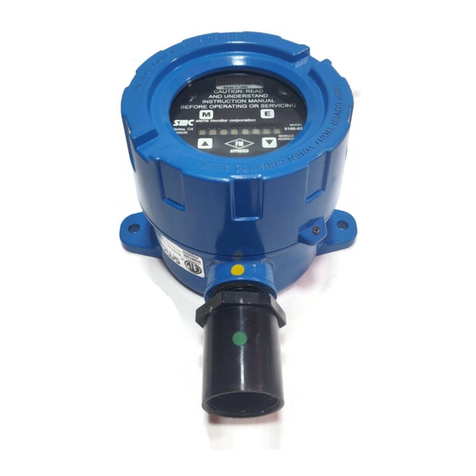
Sierra Monitor Corporation
Sierra Monitor Corporation 5100-02-IT User manual
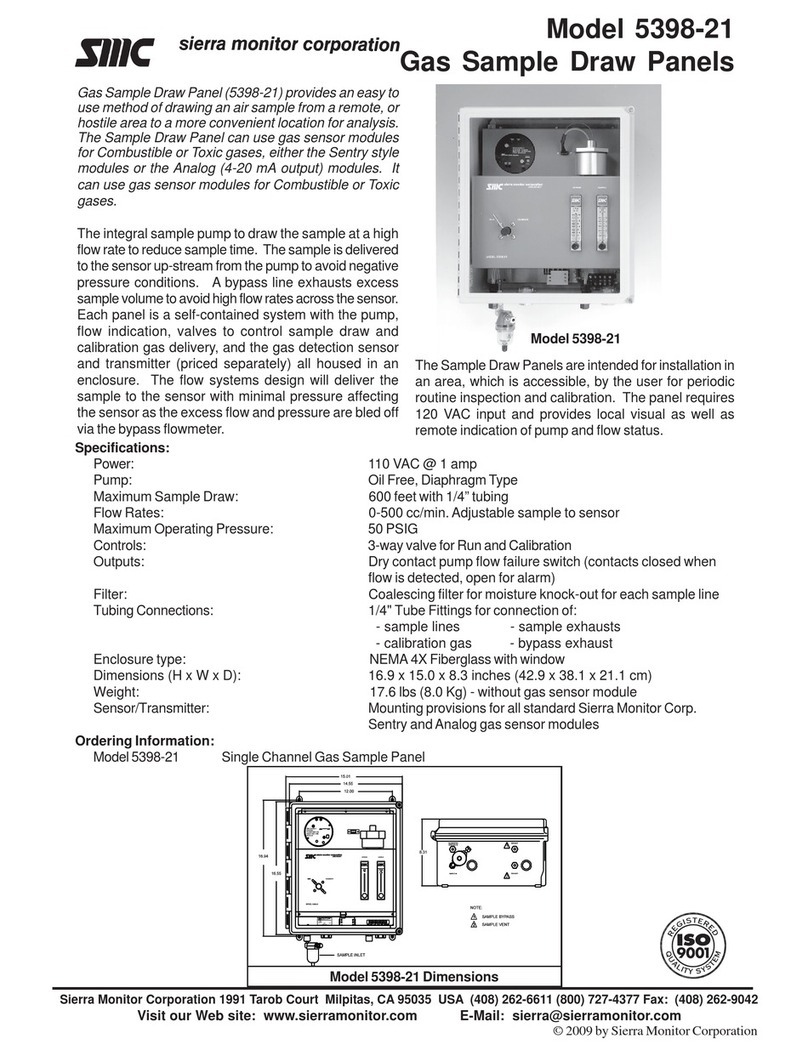
Sierra Monitor Corporation
Sierra Monitor Corporation 5398-21 User manual
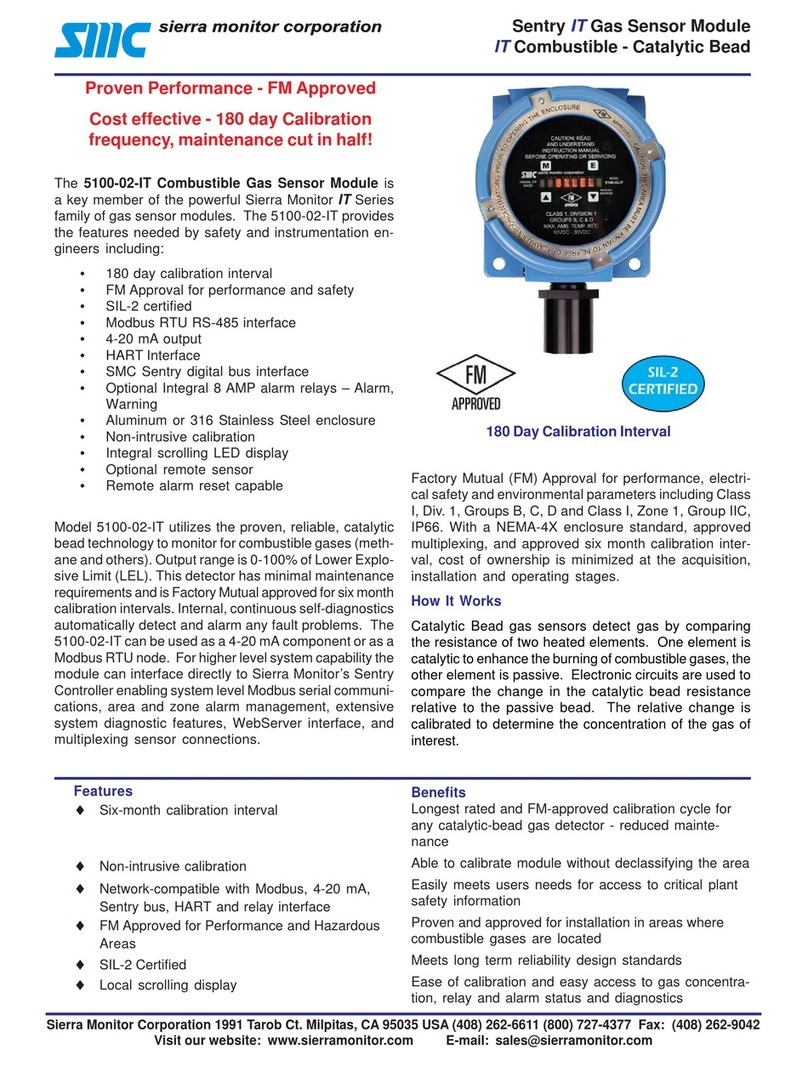
Sierra Monitor Corporation
Sierra Monitor Corporation 5100-02-IT User manual
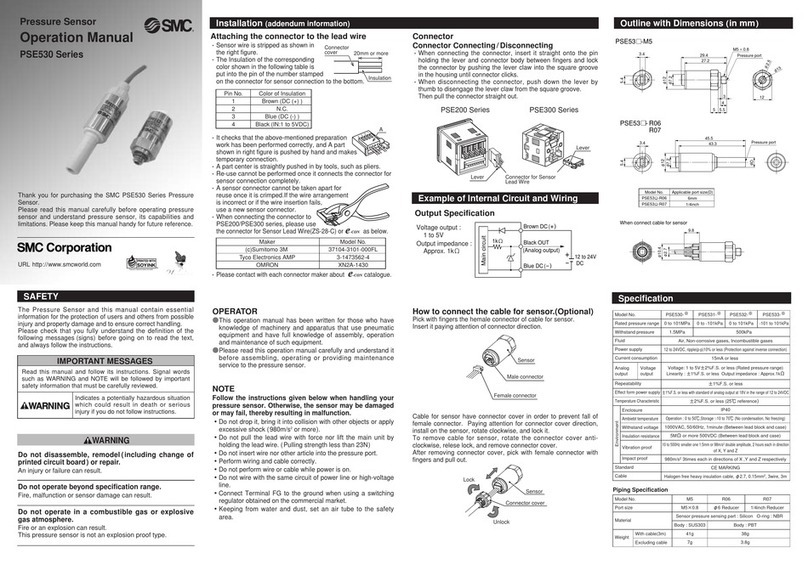
Sierra Monitor Corporation
Sierra Monitor Corporation PSE530 Series User manual
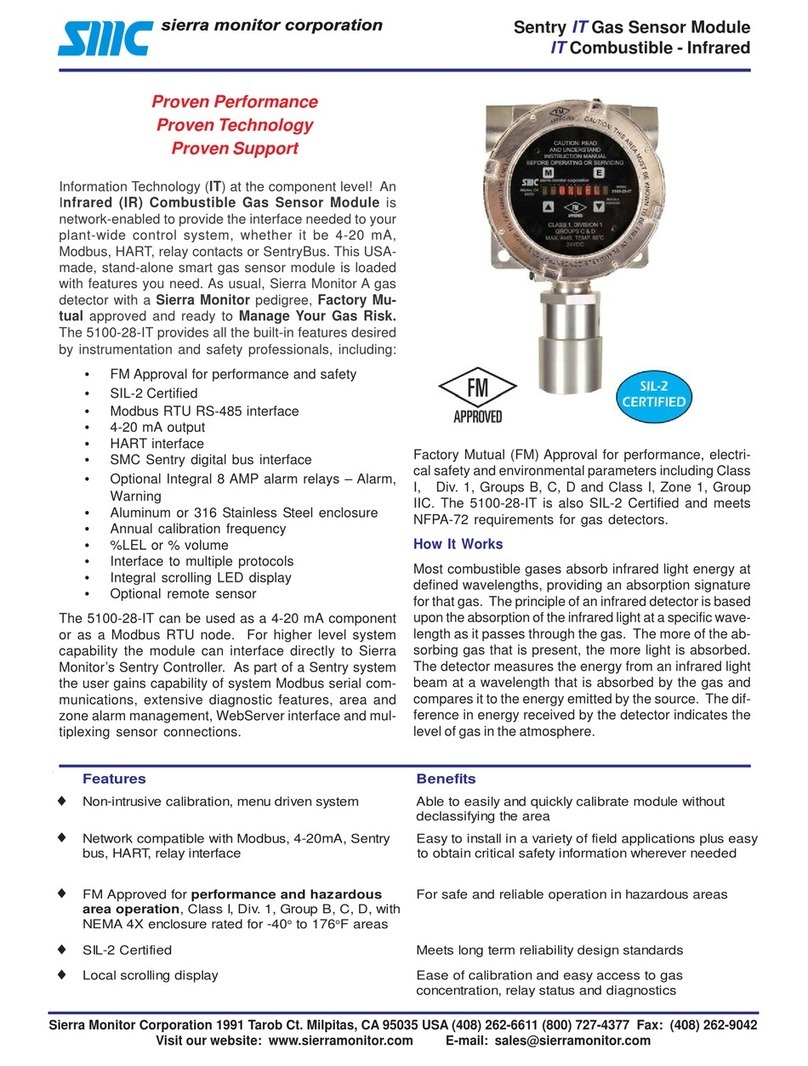
Sierra Monitor Corporation
Sierra Monitor Corporation Sentry 5100-28-IT User manual
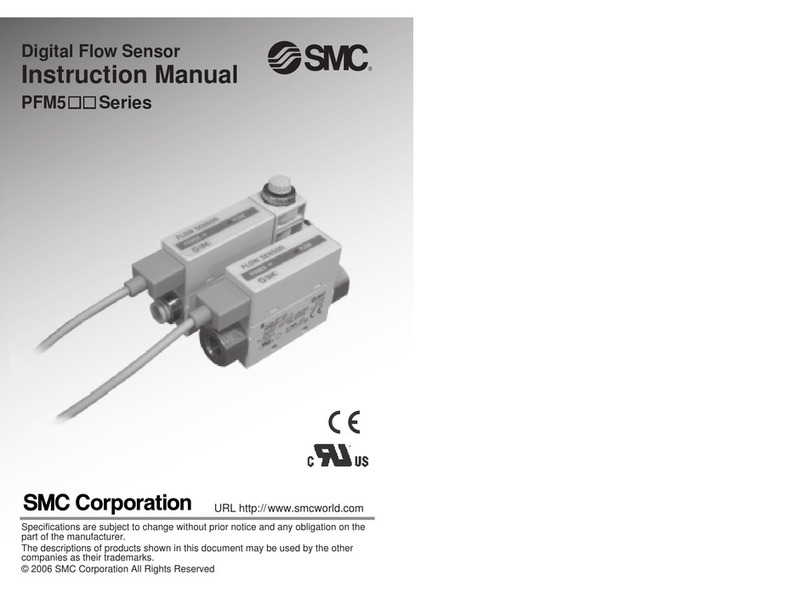
Sierra Monitor Corporation
Sierra Monitor Corporation PF5M User manual

Sierra Monitor Corporation
Sierra Monitor Corporation HRG010-W User manual

















